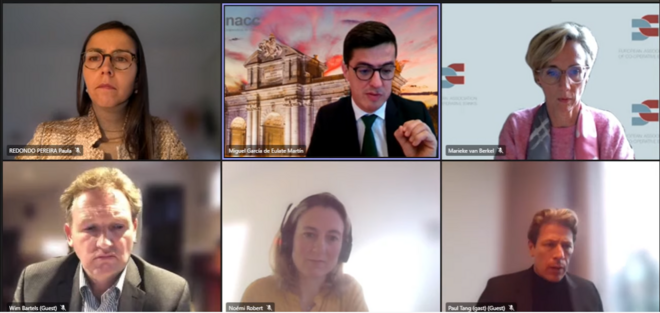Wednesday 1st of December, the EACB together with Accountancy Europe organised the webinar “How to build a credible green bond market”. The online event brought together speakers from the European Commission, the European Parliament, Accountancy Europe, the Luxembourg Stock Exchange and the EACB to debate on how green bonds can help achieve a climate-neutral Europe by 2050 and the proposal by the European Commission for a standard to certify green bonds in the EU.
The European Union Green Bond Standard (EUGBS) for EU green bonds issuance, introduces requirements aiming at reducing uncertainties for issuers and investors, and bringing credibility to the green bond market. Representing the co-operative banking sector in the event, Miguel García de Eulate, Capital Markets advisor at the Spanish Association of Cooperative Banks (UNAAC), highlighted that co-operative banks' features involve proximity to the real economy of the EU's countries and regions by financing SMEs and families which helps maintain a lively and sustainable community-focused society. He stressed the importance of the green bond tool for co-operative banks in generating funding to finance the green activities of clients and explained that unlike corporates, banks are not the asset owner but are owner of the loan which is the liability to the client. Asked about his main observations regarding the Green Bond Standard he commented: “The EACB welcomes the EU Green Bond Standard as a key building block in the road to a Sustainable finance framework. But in terms of defining the grandfathering clause, the emphasis should be on the underlying asset and not the bond. This would thus allow for ‘full grandfathering’ to apply until maturity of the bond. We [the EACB and its members] think that this link between bank green bonds and full grandfathering will continue contributing to the current positive evolution in green bond markets”.
The speakers also discussed the role of the EU Taxonomy Regulation in the proposal, which was supported as the foundation for developing the standard. Miguel García de Eulate added: “The alignment of the use of proceeds to the Taxonomy’s technical screening criteria is a positive development behind the standard. But it is still important to grant a full grandfathering to maturity in order to bring banks into this journey of granting green loans, by providing the legal certainty that the loans granted at time of issuance, and not the bonds themselves, remain applicable under the standard and with each revision of the Taxonomy technical screening criteria.” The voluntary nature of the standard was considered the right way to go, certainly in the short term. It was further stressed that when it comes to the question of greenwashing, the green bond standard is a very good step forward but, in any case, not the only tool to use. Other building blocks such as the CSRD and Green asset ratio will also play a role in taking care that the nature of activities being financed are being displayed.
To close the event, Marieke van Berkel, Head of Retail Banking, Payments, Digitalisation & Financial Markets at the EACB, stressed: “The coming months will continue to see debates on the green bond standard particularly in the European Parliament, the European Council and among stakeholders, as it is one of the many vital building blocks that should help Europe to become climate-neutral by 2050. But it is important to already note that each of the stakeholders represented here today have already demonstrated their commitment to do their part in making the standard fit for that objective”.
To read more about the full position of the EACB on the Proposal for a Regulation on European Green Bonds, please click here.



